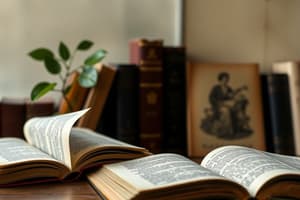Podcast
Questions and Answers
What is one of the primary functions of the literature of knowledge?
What is one of the primary functions of the literature of knowledge?
- To inspire creativity
- To evoke deep-seated feelings
- To entertain and amuse
- To educate and inform (correct)
Which of the following is NOT a standard of good literature?
Which of the following is NOT a standard of good literature?
- Permanence
- Commercial appeal (correct)
- Intellectual value
- Artistry
How does literature enhance imagination?
How does literature enhance imagination?
- By providing historical facts
- By vividly expressing creative ideas (correct)
- By creating laughable characters
- By teaching moral lessons
Which value learned through literature is associated with understanding the nature of beauty?
Which value learned through literature is associated with understanding the nature of beauty?
What does literature appeal to in humans?
What does literature appeal to in humans?
Which of the following is a characteristic of both oral and written literature?
Which of the following is a characteristic of both oral and written literature?
What role does literature primarily play in socio-political contexts?
What role does literature primarily play in socio-political contexts?
Which type of literature speaks to the discursive understanding?
Which type of literature speaks to the discursive understanding?
What is the primary method of direct characterization?
What is the primary method of direct characterization?
Which of the following is NOT a type of indirect characterization?
Which of the following is NOT a type of indirect characterization?
Which statement best defines a theme in literature?
Which statement best defines a theme in literature?
What does foreshadowing contribute to a story?
What does foreshadowing contribute to a story?
What is meant by 'setting' in literature?
What is meant by 'setting' in literature?
Which point of view is characterized by the narrator telling the story from their own perspective?
Which point of view is characterized by the narrator telling the story from their own perspective?
What type of setting focuses on emotional or atmospheric descriptions in a narrative?
What type of setting focuses on emotional or atmospheric descriptions in a narrative?
What distinguishes third-person point of view from first-person?
What distinguishes third-person point of view from first-person?
What defines an internal conflict?
What defines an internal conflict?
Which description best fits a complex character?
Which description best fits a complex character?
What does the theme of a story typically represent?
What does the theme of a story typically represent?
Which of the following is a characteristic of symbolism in literature?
Which of the following is a characteristic of symbolism in literature?
What is typically included in the setting of a story?
What is typically included in the setting of a story?
What best describes tone in a literary context?
What best describes tone in a literary context?
Which statement describes an external conflict?
Which statement describes an external conflict?
What role does the antagonist typically play in a narrative?
What role does the antagonist typically play in a narrative?
What is the primary difference between an omniscient narrator and a limited omniscient character?
What is the primary difference between an omniscient narrator and a limited omniscient character?
Which of the following best describes verbal irony?
Which of the following best describes verbal irony?
What does 'diction' primarily refer to in literary analysis?
What does 'diction' primarily refer to in literary analysis?
Which type of symbolism is recognized universally across cultures?
Which type of symbolism is recognized universally across cultures?
What is the meaning of connotation in literary terms?
What is the meaning of connotation in literary terms?
What is the primary theme of John Milton's poem 'On His Blindness'?
What is the primary theme of John Milton's poem 'On His Blindness'?
Which of the following tones best conveys a sense of distrust or skepticism?
Which of the following tones best conveys a sense of distrust or skepticism?
Which of the following characteristics defines a villanelle?
Which of the following characteristics defines a villanelle?
In what scenario would situational irony most likely occur?
In what scenario would situational irony most likely occur?
What primarily distinguishes formal diction from informal diction?
What primarily distinguishes formal diction from informal diction?
What form does a classical haiku poem take?
What form does a classical haiku poem take?
In Shakespeare's Sonnet 116, love is described as all of the following EXCEPT:
In Shakespeare's Sonnet 116, love is described as all of the following EXCEPT:
What is the main purpose of figurative language in literature?
What is the main purpose of figurative language in literature?
What does the phrase 'They also serve who only stand and wait' imply in 'On His Blindness'?
What does the phrase 'They also serve who only stand and wait' imply in 'On His Blindness'?
Which of the following describes an elegy?
Which of the following describes an elegy?
What literary device does alliteration represent?
What literary device does alliteration represent?
Flashcards are hidden until you start studying
Study Notes
Literature
- Literature is a form of expression using written words.
- It showcases human creativity through artistry and skill.
- Derived from the Latin 'literatura' meaning 'writing', it encompasses both oral and written traditions.
- It reflects societal and individual realities, providing insights into human nature and cultural values.
Importance of Literature
- Provides aesthetic pleasure through imaginative storytelling and impactful language.
- Enhances imagination and enables the exploration of different perspectives.
- Offers insight into human nature and explores diverse human experiences.
- Evokes deep-seated emotions and feelings within readers, prompting self-reflection.
- Expands knowledge and understanding of various fields like history, politics, philosophy, and science.
Standards of Good Literature
- Artistry: Highlights skill and technique in writing, employing figurative language and engaging storytelling.
- Intellectual Value: Stimulates critical thinking, raises thought-provoking questions, and encourages analysis.
- Suggestiveness: Prompts readers to draw inferences, explore multiple interpretations, and engage with complex concepts.
- Spiritual Value: Addresses themes of morality, ethics, and spirituality, prompting reflection on human existence and purpose.
- Permanence: Enduring themes and timeless messages that resonate across generations and cultures.
- Universality: Deals with common human experiences and emotions that transcend specific cultural contexts.
Additional Values Learned Through Literature
- Aesthetic/Artistic: Explores beauty, human creativity, and artistic expression across different forms.
- Historical: Provides understanding of past events, social contexts, and historical evolution.
- Socio-political: Reflects societal dynamics, power structures, and cultural conflicts, sometimes prompting social change.
- Moral: Imparts ethical lessons and inspires readers to lead more meaningful lives.
- Religious/Ethical: Examines religious beliefs, moral principles, and spiritual values, fostering contemplation on human existence.
- Scientific/Cultural: Offers insights into the author's time and culture, sheds light on scientific advancements, and explores cultural practices.
- Philosophical: Investigates human knowledge, explores philosophical concepts, and examines the nature of existence.
- Entertainment: Provides enjoyment and serves as a means of escapism and relaxation.
Two Separate Offices of Literature
- Literature of Knowledge: Aims to educate and teach, focusing on conveying information and factual knowledge.
- Literature of Power: Primarily seeks to move and affect the reader emotionally, aiming for an impact on their feelings and imagination.
Literary Ideals/Standard
- Intellectual Value: Explores complex ideas, challenging readers to analyze, interpret, and engage with different perspectives.
- Conflict: Central to storytelling, either internal (within characters) or external (between characters or against the world).
- Characters: Developments range from simple (stereotypical) characters with one or two defining traits to complex (rounded) characters with multiple traits and complexities.
- Theme: Underling message or idea behind a story, often about universal human concerns or ethical dilemmas.
- Symbolism: Objects, images, or actions that carry meanings beyond their literal interpretation.
- Setting: Time and place of the story, including cultural context, physical environment, and historical circumstances.
- Tone: Narrator's attitude towards the subject, conveyed through word choice and sentence structure.
- Point of View: Perspective from which the story is told, ranging from first-person, second-person, or third-person narration.
- Characterization: How authors develop and reveal their characters through actions, dialogue, and interactions with others.
- Foreshadowing: Hints and clues within the text that suggest future events and build suspense.
Literary Terms
- Tone: The author's attitude towards the subject.
- Irony: Contrast between what is said and what is meant.
- Verbal Irony: A statement with the opposite implication of its literal meaning.
- Situational Irony: An outcome that contradicts expectations.
- Dramatic Irony: The audience knows something the characters do not.
- Diction: Word choice and phrasing specific to a text.
- Denotation: Literal meaning of a word as found in the dictionary.
- Connotation: Emotional and cultural associations linked to a word or phrase.
- Symbolism: Use of objects, ideas, or actions to represent more than just literal meaning.
- Universal Symbolism: Shared meaning across cultures.
- Conventional Symbolism: Shared meaning within a particular society.
- Contextual Symbolism: Meaning specific to the text.
- Imagery: Sensory language that creates vivid mental pictures.
Poetic Forms
- Sonnet: A 14-line poem with a specific rhyme scheme and structure.
- Italian (Petrarchan) Sonnet: Divided into an octave (eight lines) and a sestet (six lines).
- English (Shakespearean) Sonnet: Divided into three quatrains (four lines each) and a final couplet (two lines).
- Villanelle: A 19-line poem with a specific rhyme scheme and repetition of two rhymes throughout.
- Sestina: Unrhymed poem with six stanzas, each using the same six words in different combinations.
- Haiku: Three-line poem with a specific syllable count (5-7-5).
Elegy
- A mournful poem expressing sorrow, often lamenting death or loss.
Figurative Language
- Alliteration: Repetition of consonant sounds at the beginning of words within a sentence.
- Figurative Language: Language used to create a more vivid or impressive effect. The opposite of literal language.
Studying That Suits You
Use AI to generate personalized quizzes and flashcards to suit your learning preferences.




